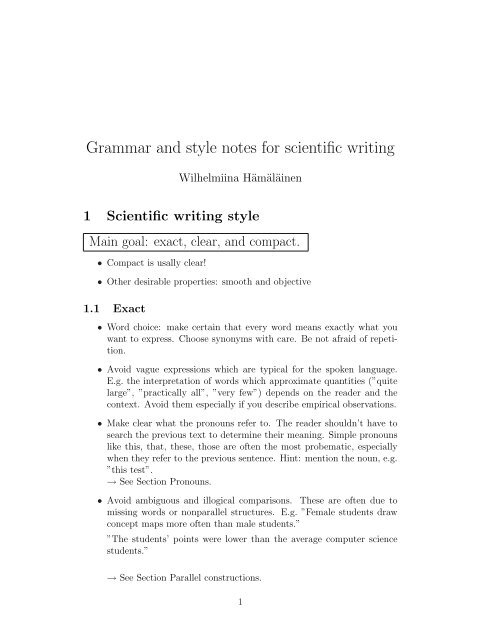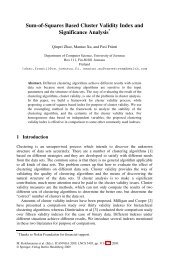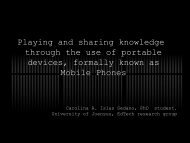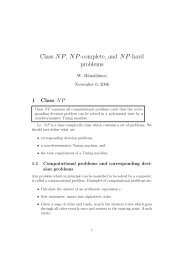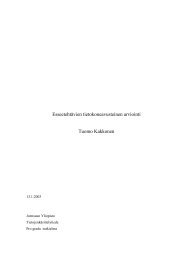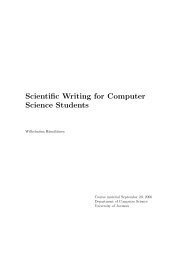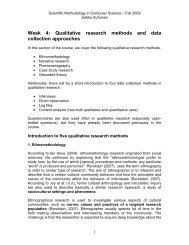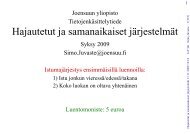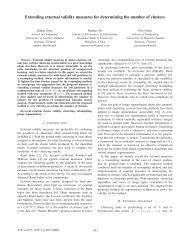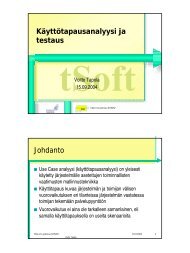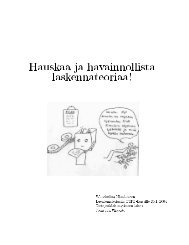Grammar and style notes for scientific writing
Grammar and style notes for scientific writing
Grammar and style notes for scientific writing
You also want an ePaper? Increase the reach of your titles
YUMPU automatically turns print PDFs into web optimized ePapers that Google loves.
<strong>Grammar</strong> <strong>and</strong> <strong>style</strong> <strong>notes</strong> <strong>for</strong> <strong>scientific</strong> <strong>writing</strong><br />
Wilhelmiina Hämäläinen<br />
1 Scientific <strong>writing</strong> <strong>style</strong><br />
Main goal: exact, clear, <strong>and</strong> compact.<br />
• Compact is usally clear!<br />
• Other desirable properties: smooth <strong>and</strong> objective<br />
1.1 Exact<br />
• Word choice: make certain that every word means exactly what you<br />
want to express. Choose synonyms with care. Be not afraid of repetition.<br />
• Avoid vague expressions which are typical <strong>for</strong> the spoken language.<br />
E.g. the interpretation of words which approximate quantities (”quite<br />
large”, ”practically all”, ”very few”) depends on the reader <strong>and</strong> the<br />
context. Avoid them especially if you describe empirical observations.<br />
• Make clear what the pronouns refer to. The reader shouldn’t have to<br />
search the previous text to determine their meaning. Simple pronouns<br />
like this, that, these, those are often the most probematic, especially<br />
when they refer to the previous sentence. Hint: mention the noun, e.g.<br />
”this test”.<br />
→ See Section Pronouns.<br />
• Avoid ambiguous <strong>and</strong> illogical comparisons. These are often due to<br />
missing words or nonparallel structures. E.g. ”Female students draw<br />
concept maps more often than male students.”<br />
”The students’ points were lower than the average computer science<br />
students.”<br />
→ See Section Parallel constructions.<br />
1
• Antropomorfism: do not attribute human characteristics to machines<br />
or other inanimate things. E.g. a computer cannot undert<strong>and</strong> data, an<br />
experiment cannot control variables or interpret findings, a table or a<br />
figure cannot compare results.<br />
• Incorrect grammar <strong>and</strong> careless sentence structures can create ambiguities!<br />
1.2 Clear<br />
• Use illustrative titles which describe the essential in a chapter or a<br />
section.<br />
• Write a brief introductory paragraph in the beginning of each chapter<br />
or section with subsections.<br />
• Divide the text logically into sentences <strong>and</strong> paragraphs.<br />
– Direct, declarative sentences with simple, common words are usually<br />
best.<br />
– Paragraphs should be logically uni<strong>for</strong>m <strong>and</strong> continuous.<br />
→ See Section Sentences<br />
• Place the adjective or the adverb as close as possible to the word it<br />
modifies.<br />
→ See Sections Adverbs <strong>and</strong> Word order.<br />
• Avoid <strong>scientific</strong> jargon = continuous use of technical vocabulary when<br />
it is not relevant.<br />
• Write numbers as digits when they refer to sizes or exact measurements.<br />
Otherwise the general rule is to write numbers < 10 as words. Express<br />
decimal numbers with a suitable precision. See APA pp. 122-129.<br />
• Use punctutation to support meaning.<br />
→ See Section Punctuation <strong>and</strong> APA pp. 78-88<br />
1.3 Compact<br />
• Say only what needs to be said!<br />
• Short words <strong>and</strong> short sentences are always easier to comprehend<br />
2
• Weed out too detailed descriptions. E.g. when you describe previous<br />
work, avoid unnnecessary details. Give a reference to a general survey<br />
or a review if available.<br />
• Don’t describe irrelevant or trivial observations (i.e. don’t mention obvious<br />
things)<br />
• Avoid wordiness, e.g.<br />
”based on the fact that” → ”because”<br />
”at the present time” → ”now”<br />
”<strong>for</strong> the purpose of ” → ”<strong>for</strong>/to sg.”<br />
Notice: ”reason” <strong>and</strong> ”because” have the same meaning → don’t use<br />
together!<br />
• Use no more words than are necessary. Redundant words <strong>and</strong> phrases<br />
(which have no new in<strong>for</strong>mation) should be omitted.<br />
• Avoid too long sentences <strong>and</strong> paragraphs<br />
1.4 Smooth<br />
• Verbs: Stay within the chosen tense!<br />
tense within<br />
No unnecessary shifts in verb<br />
– the same paragraph<br />
– in adjacent paragraphs<br />
→ See Section Verbs.<br />
• Use verbs rather than their noun equivalents<br />
• Prefer active to passive voice<br />
• Avoid long noun strings!<br />
Hint: sometimes you can move the last word to the beginning <strong>and</strong> fill<br />
in with verbs <strong>and</strong> prepositions<br />
• Each pronoun should agree with the referant in number <strong>and</strong> gender.<br />
• Transitional words help to maintain the flow of thought<br />
3
– time links: then, next, after, while, since<br />
– cause-effect links: there<strong>for</strong>e, consequently, as a result<br />
– addition links: in addition, moreover, furthermore, similarly<br />
– contrast links: but, however, although, whereas<br />
• Notice: some transitional words (while, since) can be used in several<br />
meanings → limit their use to their temporal meaning! (Use ”because”<br />
instead of ”since”; ”although”, ”whereas” or ”but” instead of ”while”,<br />
when there is no time connection.)<br />
• Use abbreviations sparingly, especially the abbreviations which you define<br />
yourself <strong>for</strong> technical terms.<br />
→ See Section Abbreviations.<br />
• Do not use emphasis (italics) when it is not needed.<br />
provide emphasis.<br />
Use syntax to<br />
• Metaphors can sometimes help to simplify complex ideas. However,<br />
– Don’t overuse them<br />
– Don’t mix several metaphors in one sentence<br />
– Avoid cliches<br />
1.5 Objective<br />
• Use the 3rd person rather than the 1st person.<br />
• Use emotionally neutral expressions, e.g. ”Students suffering from dyslexia”<br />
→ ”students who have dyslexia”<br />
• Use words which are free from bias (implied or irrelevant evaluation)<br />
Especially, be careful when you talk about<br />
– gender<br />
– marital status<br />
– racial or ethnical groups<br />
– disability<br />
– age<br />
→ See Section Gender-neutral language.<br />
4
Hints:<br />
• Select an appropriate degree of specifity. When in doubt, prefer the<br />
more specific expression. E.g.<br />
– Instead of ”man” use ”men <strong>and</strong> women” or ”women <strong>and</strong> men” to<br />
refer to all human beings<br />
– Instead of ”old people” define the age group ”ages 65-83”<br />
– Instead of ”Asian” mention the nationality ”Chinese”<br />
• Differences should be mentioned only when relevant. Careless use of<br />
biassed words can create ambiguities.<br />
E.g. avoid the use of ”man” as a generic noun or an ending <strong>for</strong> an<br />
occupational title. Otherwise it can imply incorrectly that all people<br />
in the group are male.<br />
2 Verbs<br />
Remember two important rules when you use verbs:<br />
1. The number of subject determines the number of verb<br />
2. Do not mix inconsistent tenses<br />
2.1 Number <strong>and</strong> person<br />
• When the subject is singular third person (she/he/it), the verb needs<br />
suffix -s (in the present, positive sentence). The auxiliary verbs have<br />
their own special <strong>for</strong>ms (is, can, has, does).<br />
• Be careful with special phrases:<br />
”A number of new experiments were done” (plural)<br />
”Plenty of time was spent...” (singular)<br />
”A few data points belong to cluster X” (plural)<br />
• Notice: when the subject is composed of a singular <strong>and</strong> a plural noun<br />
by ”or” or ”nor”, the verb agrees with the noun that is closer.<br />
• If the number of the subject changes, retain the verb in each clause.<br />
E.g. ”The positions in a sequence were changed <strong>and</strong> the test rerun” →<br />
”The positions in the sequence were changed, <strong>and</strong> the test was rerun.”<br />
5
2.2 Tenses (temporal <strong>for</strong>ms)<br />
• Default: the present<br />
• Past or present prefect (but not both) when you describe previous<br />
research (literature review)<br />
• Past tense to describe the experiments <strong>and</strong> their results<br />
• In <strong>scientific</strong> <strong>writing</strong>, the default is present (is). With present, you can<br />
combine perfect (has been) (<strong>and</strong> future, will be) if needed, but not the<br />
other tenses.<br />
• Use past tense (was) only <strong>for</strong> good reasons. It expresses that something<br />
belongs to the past <strong>and</strong> has already finished. E.g. when you report your<br />
experiments.<br />
• Past perfect (had been) is seldom needed. It is used, when you describe<br />
something in the past tense, <strong>and</strong> you refer to something which<br />
has happened be<strong>for</strong>e it. E.g.<br />
”We tested the system with data which had been collected in Programming<br />
1 course.”<br />
• Notice: Use ”would” with care! It expresses a conditional action. E.g.<br />
”it would appear” → ”it appears”.<br />
2.3 Active or passive voice, which person<br />
2.3.1 Use of passive voice<br />
• In active voice the actor is known, while in passive voice it is unknown.<br />
• In the basic <strong>for</strong>m of passive (”sg is done”), you can express also the actor<br />
(”sg is done by sy”). Expressing the actor is always more in<strong>for</strong>mative!<br />
• It is often recommended to prefer active voice, but in <strong>scientific</strong> <strong>writing</strong><br />
passive voice is sometimes convenient. It allows us to draw the<br />
reader’s attention to the phenomenon or the event, instead of the actor.<br />
E.g. ”The probabilities are updated by Bayes rule”, ”The values<br />
are recorded every minute”.<br />
6
• Often the purpose determines the voice. Usually we want to begin with<br />
a familiar word <strong>and</strong> put the new in<strong>for</strong>mation in the end. E.g. be<strong>for</strong>e an<br />
equation or a definition, we can say ”The model is defined as follows.”.<br />
• However, do not overuse passive, <strong>and</strong> do not chain passive expressions.<br />
As a rule of thumb, use only one passive per sentence<br />
• Read Section 11 in Strunk: ”Elements of <strong>style</strong>”! (link in the course<br />
page)<br />
2.3.2 ”It is” <strong>and</strong> ”There is/are”<br />
• A <strong>for</strong>mal subject ”it” is sometimes used in passive expressions: ”It is<br />
often recommended [reference] that...”<br />
• Typical verbs in this expression are: say, suppose, consider, expect.<br />
• ”There is/there are” is a similar expression, but now we don’t need the<br />
passive. This expression is used when the real subject (what is somewhere)<br />
comes later <strong>and</strong> we haven’t mentioned it be<strong>for</strong>e.<br />
E.g. ”There was only one outlier in the data set 1” v.s. ”The outlier<br />
was in the data set 1.”<br />
• The verb is nearly always ”be” (sometimes ”exist” or something else)<br />
• Notice that the verb follows the real subject’s number.<br />
E.g. ”There were a lot of outliers in the data set 1.”<br />
• ”There is” expression is seldom needed in <strong>scientific</strong> <strong>writing</strong>, <strong>and</strong> often<br />
you can circumvent it:<br />
”The data set 1 contained a lot of outliers.”<br />
2.3.3 Other passive expressions<br />
• ”We” can be used as passive. E.g. ”In Chapter X, we define the basic<br />
concepts.” However, it is better to say ”The basic concepts are defined<br />
in Chapter X.”<br />
• ”You” is sometimes used as passive, especially in manuals. Don’t use<br />
it in <strong>scientific</strong> text!<br />
• ”People” when you refer generally to people. Quite a vague expression,<br />
not recommendable!<br />
7
2.3.4 Person<br />
• Basic rule: avoid the first person (no opinions, but facts). However,<br />
sometimes we can use ”we” as a passive expression. Problem: whom<br />
you are referring to, if you write alone<br />
• Referring to yourself: you can talk about ”the author”. E.g. ”All programs<br />
have been implemented by the author.” Notice that I don’t<br />
guarantee that your supervisor likes this! Some supervisors prefer ”I”.<br />
• Gender-neutral language: when you refer to an unknown user, student,<br />
etc. try to use gender-neutral language.<br />
– The most common way is to say ”she/he” or ”he or she”. Some<br />
authors are careful about the order of her/him, as well! E.g. you<br />
can use every second time ”she or he” <strong>and</strong> every second time ”he<br />
or she”. Remember to put the other pronouns in the same order<br />
(”She/he tries her/his best”)<br />
– ”One” is neutral, but sounds often awkward. ”The learner can<br />
define one’s own learning goals”<br />
– Sometimes you can avoid the problem by using plural.<br />
2.4 Other <strong>notes</strong><br />
• Do not use short <strong>for</strong>ms ”isn’t, can’t, doesn’t”, but ”is it, cannot, does<br />
not”.<br />
• ”be verb+ing” <strong>for</strong>m when something is currently happening or takes<br />
some time. E.g. ”Thread 2 can be started in the same time when thread<br />
1 is still running”<br />
• Some verbs require that the following verb is in -ing <strong>for</strong>m:<br />
{enjoy, avoid, succeed in, finish, keep, mind, practice, risk} + verb +<br />
ing<br />
E.g. ”Students enjoyed learning new things”<br />
• Special phrases: ”be used to”, ”be (un)likely to”<br />
8
2.5 Noun syndrom<br />
”Noun syndrom” = use of common verbs {be, do, have, make, ...} + a noun<br />
E.g. ”We can get better underst<strong>and</strong>ing...”,”Different people have different<br />
responses to the methods”<br />
⇒ Prefer illustrative verbs!<br />
Task: How would you correct the previous sentences<br />
Useful verbs:<br />
represent, analyze, compare, demonstrate, illustrate, summarize, conclude,<br />
list, define, report, model, implement, design, consider, involve, simplify,<br />
generalize, per<strong>for</strong>m, be based on sg., take into account sg., depend on sg,<br />
increase, decrease, evaluate, predict, assign, require, satisfy, ...<br />
Task: What is the difference between the following concepts Give examples<br />
when they are used!<br />
evaluate – assess<br />
compute – calculate<br />
derive – infer<br />
approximate – estimate<br />
discover – find<br />
2.6 Often needed irregular verbs<br />
The following list contains irregular verbs which are sometimes needed in<br />
computer science expressions, excluding the most common ones (which all of<br />
you know!):<br />
choose – chose – chosen<br />
find – found – found<br />
hide – hid – hidden<br />
hold – held – held<br />
lead – led – led<br />
lose – lost – lost<br />
rise – rose – risen<br />
seek – sought – sought<br />
show – showed – shown<br />
9
spin – spun – spun<br />
split – split – split<br />
spread – spread – spread<br />
stick – stuck – stuck<br />
In addition, the last consonant can be doubled be<strong>for</strong>e -ed, if<br />
• if the spell is short <strong>and</strong> stressed: planned, dropped,<br />
• the consonant is ’l’: travelled, modelled, biassed<br />
Notice: American English is not so strict, <strong>and</strong> ispell can complain about<br />
correct spelling!<br />
10
Exercise<br />
Read the given text part <strong>and</strong> underline useful expressions. Search especially<br />
the following kind of expressions:<br />
• Useful verbs <strong>and</strong> their prepositions in computer science texts.<br />
• How to list advantages or disadvantages without repetition (usually in<br />
the beginning of sentences).<br />
• How to compare approaches<br />
• Any other useful expressions!<br />
The same text is given to two people. Thus, you can discuss with your pair,<br />
if you don’t underst<strong>and</strong> something. However, it is not important if you don’t<br />
underst<strong>and</strong> all words.<br />
11
3 Extra material: Tricks <strong>for</strong> gender-neutral<br />
language<br />
Trick Incorrect Correct<br />
Use plural The student returned his solution. The students returned their solutions<br />
Article ”the”<br />
The student returned the solution.<br />
Drop the pronoun The user himself defines the The user defines the preferences.<br />
preferences.<br />
Special expressions man, mankind people, human beings, humankind<br />
man-machine interface<br />
user-system interface,<br />
human-computer interface<br />
Researchers’ wives<br />
Researchers’ spouses<br />
mothering<br />
pareting, nurturing<br />
chairman<br />
chairperson, chair, head<br />
Mrs. Smith<br />
Jane Smith<br />
housewife<br />
homemaker<br />
12


